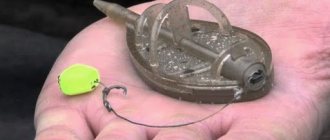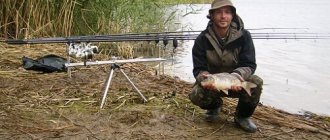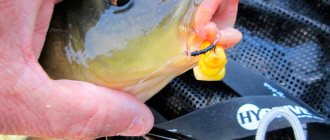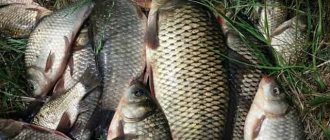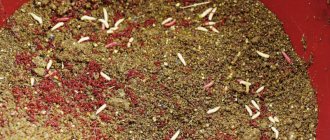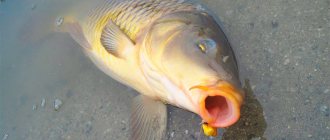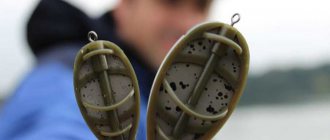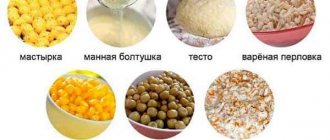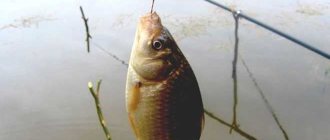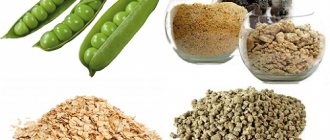So, which sludge is good and which is bad?
Most anglers, when diligently searching for the most suitable fishing point on the bottom, try to follow strict rules: taking into account changes in depth, smooth transitions from hard to soft areas, etc. At the same time, absolutely “bypassing” all the silt. However, in fact, it can be different: on the one hand, completely unsuitable, and on the other, very useful. Let's take it in order.
A clear example of “dead” unusable sludge that is dangerous to fish health
Unsuitable sludge
It is not difficult even for a beginner to correctly identify bad mud for carp fishing, since its characteristic features are a fetid odor and a characteristic black color. Moreover, if you touch it in your hands, it will immediately “unpleasantly” stick to them. In the “thickness” of such sludge, chemical reactions actively occur, the by-products of which are dangerous acids and methane. Therefore, it is easy to guess that living organisms will not survive in such an environment, which means that carp will not be able to profit from anything there. Moreover, he will even avoid these places.
Normal sludge
Unlike the previous version, this is already a good-smelling sludge, literally replete with a lot of nutrients for carp. And not only bloodworms, plankton, larvae or other “goodies” (found or stuck inside), but also minerals that are very useful for the body of carp. In addition, “living” sludge, unlike “dying” sludge, produces oxygen, which also attracts fish by nature.
Chod / "Chod" (English)
According to experienced carp anglers, it is considered an ideal point for carp fishing. You can even argue that many fishermen caught their trophies in precisely such places, without even realizing it (confusing the paths “compacted” by fish with the usual hard bottom). Basically, it is young silt, consisting of a wide variety of natural waste, mixed with living plants.
It is definitely worth noting that even after “cleaning” such places “cleanly”, carp after a while return to them again, since they have already found tasty food there.
Fishing with a feeder on a muddy bottom, how to fish?
HomeContentBlogs (photo reports, diaries, notes, videos) Blog entry
Starnak
Blog entry date: 05/04/2021 Blog entry date: 05/04/2021
3
A question that I get asked very often is related to the peculiarities of feeder fishing on reservoirs with a muddy bottom. In this video I will try to tell my thoughts on this topic.
A small layer of silt won't hurt us. When the layer of silt is large, 30 cm or more, problems may arise with the availability of bait and bait for fish. And it is these problems that we will try to solve in various ways. Ready? Go!
Relief
You can completely eliminate all issues related to silt by finding a section of solid bottom. In addition, such an area against the backdrop of the surrounding silted bottom will be simply an excellent place for fishing. Therefore, we are not lazy and carefully study the bottom. This should always be done, but in this case the importance of this point increases significantly. Having found such a place, we fish on the border with silt (but with a shift towards the hard bottom, of course), or in the center if the area is small. Now what to do if we haven’t found anything like that, no matter how hard we tried.
Lure
The moment with bait is very important. If we correctly attract fish to the fishing point, then it will rummage even in deep mud in search of food and, in the end, will find our hook. We need to do everything to make it easy and convenient for her to do this.
We make active dusting bait. It is worth looking for such bait among roach mixtures. If, due to fishing conditions, we need a different bait, then we mix the composition that we want to use with part of the roach mixture to increase activity. The dusty column will certainly go beyond the boundaries of the bottom silt and attract fish to the fishing point.
In any case, we make the bait semi-dry, and even fairly inert compounds will be more active. And one more thing that is worth taking into account is a jerk right before the feeder hits the bottom. The purpose of this action is to release the bait from the feeder BEFORE the feeder falls to the bottom. The bait will settle on the layer of silt and sink more slowly and, possibly, in separate particles to a shallower depth.
Nozzle
Floating variations can be used as a nozzle. These include artificial ottomans, perhaps even boilies (it all depends on the target fish), folk foam, puffed wheat, maggots or worms pumped through a syringe with air, and so on. It makes sense to dip all baits that sink so that smell detection works for the fish.
Feeder
What can we do about feeders? It would be great if the feeder sank very slowly into our layer of silt, rather than sinking like a stone to the bottom. A simple trick will help you achieve this. We take a piece of polystyrene foam and tape it to the feeder. By experimenting underfoot, we ensure that the feeder slowly sinks.
Leash
It is worth making the installation with a long leash. Moreover, the length must be selected taking into account the layer of silt. First, the feeder will fall to the bottom, then the leash will slowly lower. When using floating nozzles, we can generally raise the nozzle above the layer of silt, so we also select the appropriate leash length. But even with sinking baits, a long leash will help the bait stay longer in the upper layers of silt and, perhaps, linger somewhere halfway, rather than falling like a stone to the bottom into less accessible layers.
If all else fails
Now a very important tip. If none of the above helped you, put the feeder aside, take a float rod and blow towards the reeds. This is not a joke, this is really one of the solutions to the problem. We make the same dusty active bait, and select the depth experimentally above the layer of silt and catch, perhaps more effectively than with bottom gear.
Tags: feeder pond
3
See also: 04/29/2021 Spinning during the spawning ban. // Mikhail Bondarev (mikebond) 05/02/2021 Daiwa Windcast Spod&Mark QDA after four seasons of operation. // Mikhail Bondarev (mikebond) 05/08/2021 Mercury 15MH 294cc. First launch and start of running. // Mikhail Bondarev (mikebond) 05/12/2021 ADAPTER for the waggler match float. // Andrey Pivovarov (Andrey240884)
Register or log in to comment.
Stepanych
-> Blog post
Fishing with a feeder on a muddy bottom, how to fish?
04.05.2021 15:02:01
Right about my BabarykThe waters are 30-40 cm, and cows that go to water are immersed up to their bellies.
Major
-> Blog post
Fishing with a feeder on a muddy bottom, how to fish?
05.05.2021 08:54:22
You need to open a business there to supply Ural bloodworms to Moscow.
How to find a suitable fishing spot
Most often, silt can be found in the deepest parts of the reservoir, which can be detected using an echo sounder. As a rule, these holes and gullies are not affected by underwater currents, so the situation there remains unchanged. As for shallow ponds with a characteristically flat bottom, the direction of the wind must be taken into account. For example, if you found out from weather center reports (using the Internet) that northeast winds predominate on your lake, then you need to look for good areas of organic silt on its opposite, that is, southwestern part.
Equipment for carp fishing on muddy bottoms
After the entry into force (in the EU) of a number of environmental laws on the protection of nature, one of which prohibits clearing lakes of vegetation (including underwater plants), among most European fishermen the most popular gear (and sometimes the only one when fishing for carp) became the “chod - rig."
Since it is this type of equipment (“floating” at a distance of 5-7 cm from the bottom) that allows you to fish in reservoirs even with a thick layer of silt, mixed with underwater grass. That is, in those areas of the pond where other fishermen often do not go, which means the carp will feel free there.
Proof of this is the fact that in 2010 the largest (and therefore most cautious) specimen in Britain was caught in a thick layer of silt on a “chod rig”.
Fishing on a muddy bottom, or “red gold”. Darren Belton
Fishing on a muddy bottom is a topical topic for our latitudes. While many strive to “defeat” the mud, the author of the article goes to meet it halfway. The article describes an interesting fishing tactic in which the bait is purposefully immersed in the mud. Why do this, in what situations and how does it work? The answers to these questions are contained in Darren Belton's article.
Why do carp like mud so much? The obvious answer is: because of what is contained in the sludge itself. This is a huge natural repository of a wide variety of food; countless living creatures of all kinds live in it. And sometimes the fish are so busy absorbing natural food in the mud that the bite may stop completely.
A variety of creatures live in the silt layer. But number one on their list is the bloodworm, the well-known mosquito larva.
The mosquito lays eggs in the water in huge quantities - several thousand at a time. They sink to the bottom. After about a week, they hatch into larvae that burrow into the mud. Thanks to the secretions of the salivary glands, the larvae glue particles of silt into a kind of tube, in which they live, protruding the front part from it. With this end they rummage through the mud, extracting various plant and animal remains. Having matured, they pupate and after some time rise to the surface of the water. Mosquitoes fly out of the pupae. Which then mate, lay eggs on the surface of the water and die.
While mosquitoes are mating, you can often see swallows diving towards the water and all kinds of fish rising to the surface. Every living thing on the pond is trying to join the feast - roach, rudd and even bream rise up in search of midges for food.
Contrary to popular belief, bloodworms are not at all rich in proteins or amino acids. But it contains a lot of iron, which is why it gets its specific red color. It also contains a small amount of lysine, which may be why carp love it so much.
If you find a place on a pond where bloodworms live, you can say that you have stumbled upon a deposit of “red gold”.
So, enough general information - let's get back to the topic of fishing on muddy bottoms. A very popular rig for muddy bottoms is the Chod Rig. The nozzle is located above the sludge or directly on its surface. In other cases, extra-long leashes are used to prevent the bait from being pulled into the mud. When carp dig through the muddy bottom of the lake in search of food, in particular bloodworms, the water bubbles up. And carp anglers are tearing their hair out because they are fishing right where they found the bubbles, but they are not getting a single bite. Why is this happening? Very simply: because they do not provide a presentation of the bait directly where the fish are feeding.
A bloodworm colony looks like a sea of red cotton, with swaying thread-like waves. But as soon as you touch it, these threads hide in their little holes.
This carp, weighing approximately 16 kg, was caught from an area with a thick layer of silt.
A bloodworm colony looks like a sea of red cotton, with swaying thread-like waves. But as soon as you touch it, these threads hide in their little holes.
When a carp is actively feeding in the mud, its head can sink into the mud up to a depth of up to 30 cm. I have caught carp whose gill covers were still covered in mud, as was their mouth.
If you are presenting a bait on or above the mud in a similar situation, you can fish with the same success on a zig-rig. Don't get me wrong, there are situations where you will have success fishing over mud. Chod was specially designed for fishing over a littered bottom. But when the fish feeds on bloodworms or digs deep into the silt in search of food, you also need to place your bait in the thickness of the silt, and not on it.
I know this is hard to believe. But, as I already said, when the fish feeds in this way, the bait should be in the thickness of the silt, and not on it. The best way to achieve this is to use a heavy sinker and a short leader. When I see a mass of bubbles in front of me, I use a sinker weighing 90 grams and a soft leash 5 cm long. Then I throw the sinker directly into the center of the bubbles - and do not slow down its flight so that it sinks as much as possible into the silt - that is, where the fish feed. I always use a tip with a bright scent, and keep a jar of tips soaked in activator for this purpose. These baits of mine have been in the dip for over a year. So they easily release the aroma, but at the same time do not absorb the smell of sludge. But really, I don't think it matters much. The bait rarely remains in the mud for a long time - and the bites are simply crazy, wild, because the fish does not expect the prick of the hook.
I like to use a strong scented bait as I think it gives the koi a bit of a beacon. I also use a very short leash. In most cases of fishing on muddy bottoms, I do not use leaders longer than 15 cm.
A carp weighing about 20 kg was caught as a result of casting into the area of visible “bubbles”
I remember well the first time I caught fish using this tactic - about 10 years ago. I fished on a small small silted pond. The usual technique there was fishing on muddy bottoms using artificial baits - floating corn, usually balanced to neutral buoyancy. So the nozzle was directly on the mud.
At dawn I woke up to see the water bubbling right in front of me - there were at least 6 different fish feeding there. But during the entire fishing period, I received only a single signal, indicating that someone had touched the fishing line.
I slightly changed the installation and nozzle - the result remained zero. It’s interesting that even though I recast several times, it didn’t scare the fish at all. They continued to eat. In desperation, I took out my sealed plum boilies, set a heavy sinker, tied a short leader - and cast it into the bubble area. I settled into my chair, feeling very upset. But after 10 minutes, without any warning, the rod simply took off. The spool was spinning so fast that I was afraid to lift the rod! Twenty minutes later there was an angry carp weighing nearly 20 kg in my landing net.
After this incident, in a similar situation, I always began to use this tactic. Like I said, you just have to believe. When you get the result, you will have no doubts.
Another clear sign that carp are feeding in mud is mud on the mat. They will actively highlight it. I saw the sludge coming out of the carp like paste from a boilie gun - black sludge mixed with eaten bloodworms. All that was left of the larvae was dry skin.
Bloodworm on a marker sinker
How to find the right place? I already mentioned bubbles - this is a 100% sign that is easy to detect. But if you don't see bubbles, but still want to make a presentation of the bait inside the sludge, then a marker will help.
The marker itself provides a lot of advantages; it’s bad that it is used less and less on the shore. Some argue that working with a marker scares the carp away and prefer to use working sinkers to find the fishing spot. Yes, this will help you find clear areas among the weeds, and will give you an idea of the nature of the bottom where you are going to fish. But the accuracy of marker equipment is very far from the usual working installation.
Marker sinker
If you use a special marker sinker that resembles a mace, it will be even more sensitive, and, most importantly, the bloodworm will remain on it.
Some are marked using a working rig, making up to 30 casts - and only then do they find what they are looking for. Using a special marker montage allows me to find the right point the first time. And who is scaring the carp here?
Anyone who knows how to use a marker can recognize gravel, hard, soft areas of the bottom, and so on. When you are trying to catch carp that feeds on larvae, you need to look for places that you would normally avoid.
Usually, when you work with a marker and find a muddy area of the bottom, you continue to search for a place where the mud is not so deep. The fish fed in this mud, “dislodged” it, and the result was a flat, hard area. Such places are great for feeding. In such cases, I like to feed a lot - not so much whole boilies, but what I call "boilie bulk".
My “boilie powder”
I crush the boilies into small crumbs and throw them with a spomb. Lots of attractiveness, but nothing nutritious. In some situations, this tactic works great. But in others, usually in August or September, carp actively feed in the mud. And then you need to look for points that I call “custard”. This is mud full of natural food for carp. It's easy to find with a marker - it feels like you're pulling a sinker across custard! If you look at the sinker, you will see maggots stuck to it. Smell the sinker - clean silt has a metallic odor. If you've ever drank water from natural springs, it smells the same. But that's not what we're looking for. If the sinker stinks terribly, then this is exactly what you need. Bloodworms settle in silt full of organic matter. These are places where autumn leaves rot, decomposing and sinking deeper throughout the year.
Fishing on a muddy bottom does not require very complex equipment. You won't need pop-ups either. An ordinary bottom boilie on a shorter leash than usual. I also feed this point with boilie powder to add a little more attractiveness.
One last thing to remember. If you successfully manage to fish at a certain point this week, this does not mean that everything will happen again next week. Over the course of a week, changes can occur in the silt layer; the fish, actively feeding, will “knock out” this area. A common mistake is to mark the distance on the working rods for the next fishing trip and cast to the same location. You need to check everything again with a marker - there is a high chance that where there used to be silt, a section of hard bottom has now formed.
Zhmenya “red gold”
But if you move to the right or left of the point, you will again fall into that same “custard”, and the bites will continue. Over the past two seasons, fishing the muddy bottom has been my personal key to success. And now, wherever I fish, the first thing I look for is silt.
On one of the reservoirs where I fished last year, all the algae died, and this gave the carp access to the bloodworm deposits. And they, of course, took advantage of this. I couldn't believe my own luck. Several throws of a marker into the area of the bubbles confirmed that they were feeding in the silt layer. As a result, on my first trip I caught a carp weighing about 15 kg and several carp weighing about 20. They all took bait immersed in the mud.
Don't be afraid of muddy bottoms. As I said at the beginning of this article, carp love mud. You will also like it when, thanks to it, you start fishing, when you discover deposits of “red gold”.
Ringing forests!
Translation by Anastasia Afanasyeva especially for www.carpfishing-media.com Use of site materials only with the permission of the editors with a mandatory active link to the source.
comments powered by HyperComments
Installations for muddy bottom
The most promising rig for catching carp in muddy bottoms is the “helicopter”, which is absolutely “not afraid” of viscous surfaces (which is typical for both good silt and suitable “chod”). Even if the sinker is tightly “buried” in the silt, there is no need to worry - the equipment will still “play”.
The following are considered completely unsuitable for carp fishing in muddy reservoirs: inline rigs or, in fact, any leader materials “wrapped” in a shell. The first ones will quickly get bogged down in the mud and immediately “drag” the leashes along with them. The latter, due to their inability to accept uneven bottom contours, create “gaps”.
My fishing tips
I wish you good health. Fishing on an old reservoir with rich thick silt and aquatic grass in the summer makes it difficult to attract roach, crucian carp or carp to the bait, since the bait and feeder sink into the silt at the bottom of the wild lake.
In a fishing store, look for a feeder feeder, a piece of polystyrene foam, a plastic ball, a main line, a leader line, a set of fishing hooks, a maggot and earthworm attachment, sweet corn and bait for a feeder for roach, bream and crucian carp.
photo - DIY floating feeder for muddy bottom - https://moisovetyorybalke.ru/
How to assemble a floating feeder with your own hands for a muddy bottom?
- First, you need to make a floating feeder feeder from a regular feeder. It is necessary to cut 30% to 40% of the volume of foam plastic to fit the size of the feeder feeder to fill the bottom of the feeder feeder.
- For a floating feeder feeder, you need to fasten a swivel with a clasp to the eye of the feeder and then tie a feeder leash to attach the feeder to the main fishing line.
photo - DIY floating feeder for muddy bottom - https://moisovetyorybalke.ru/
- The total length of the leash for the feeder is from 12 cm to 15 cm, where we tie the swivel to the eye of the feeder, and then at the other end we tie the swivel with a clasp to the leash. In this option, several fishing knots are used - a palomar and a classic clinch, depending on the convenience of tying them to the feeder and swivel.
- The main fishing line for the feeder reel on the feeder uses 0.25 mm, 0.30 mm and 0.35 mm, which option to choose is up to the feeder lover.
photo - DIY floating feeder for muddy bottom - https://moisovetyorybalke.ru/
- We put a silicone stopper on the main line.
- Then we put on a leash with a floating feeder feeder, threading the main fishing line into the eye of the swivel.
photo - DIY floating feeder for muddy bottom - https://moisovetyorybalke.ru/
- We install a plastic ball and tie a lead weight behind the eye of the weight. I use the Palomar universal fishing knot.
- It remains to install two leashes with fishing hooks.
- We tie a leash from 40 cm to 1.5 meters and a fishing hook to the base of the lead weight.
- We knit the second hook on top of the floating feeder on the main fishing line.
- To begin with, we knit a side loop using a single knot, for example, and be sure to moisten the place of the knot with saliva.
photo - DIY floating feeder for muddy bottom - https://moisovetyorybalke.ru/
- Then we create a leash with a hook from 15 cm to 35 cm, at the end of the leash we knit a loop from a figure eight and connect it with a side loop in a loop-to-loop knot.
- All that remains is to go fishing and test a floating feeder at the bottom of a muddy pond.
photo - DIY floating feeder for muddy bottom - https://moisovetyorybalke.ru/
Donate for development - for Christ's sake!
https://money.yandex.ru/to/41001136019007
Was the fishing information useful? Put ??????
??? Share a recent article??
My fishing tips:
Bait for carp fishing in muddy ponds
The most important conditions for choosing the right bait for carp in muddy bottoms are bright color and light weight (so that it stays on the soft surface of the mud). That is why the optimal solution would be to use bait boilies (you can do it straight from the package). Just not (!) solid ones, as they will get lost in the thickness, thereby encouraging the fish to look for food in the lower layers. Thus, bright and loose bait (neatly and evenly lying on the silty bottom) will be visible to the carp from afar.
Naturally, you can add other elements to the finished mixture. For example, from natural and cheap corn grains to any crushed store-bought additives. Flaxseed oil is considered the ideal flavoring agent for catching carp in silt, since it not only attracts fish, but also excellently (according to its characteristics) retains odors for a long time. At the same time (and this is important), it steadily interrupts the specific “aromas” of sludge.
All about fishing in Il
The first thing I always try to do is understand the type of body of water I'm fishing on. To do this, I turn to the history of the reservoir, or rather to the moment of its formation. I am not interested in the exact year, only the approximate time period and, if possible, the method of formation. Many of Europe's largest bodies of water were formed during the last Ice Age about 11,000 years ago. As a rule, they all have a deep basin left by a glacier. If the reservoir is located on a hill, then there will not be much vegetation in it, and the slopes of the basin will be covered with a layer of silt. But it will also be possible to find other interesting layers of sedimentary rock.
A clear example of this type of reservoir: the depth in one area of the water area reaches 15 m or more, and there are no sharp changes, as if the entire reservoir is gradually deepening to one point. The closer to the deep-sea zone, the thicker the layer of silt and the softer it is. I talked to divers who sank to the bottom of such pits. According to them, in some waters it was difficult to understand where the bottom began, since in the lower layers the silt had the consistency of porridge with zero visibility.
In contrast to the silt, the shallow half of the reservoir is usually covered with a layer of bright yellow sand. The sand is visual evidence of what was in the glacier.
However, if the reservoir is located in a lowland with fertile soil where a glacier once stopped, then there is a high probability that the reservoir will have several distinctive layers. One layer will contain the remains of the glacier, and the second, formed over time, will usually be a silt layer rich in nutrients. True, one can only guess about the thickness of the silt, but for the fisherman the layer will feel endless.
Most glacier-formed reservoirs in low-lying areas are reaching the end of their “life cycle.” Time and the addition of more and more layers of dead algae, the remains of animals and trees, gradually turn the waters into a swampy area. Obviously, if carp still lives in them, then you can fish there, but you should be prepared for an extremely soft bottom surface.
Another popular type of reservoir is water area created by man, for example, for irrigation of fields or other purposes. All of them have a dam to regulate the movement of water and are characterized by abundant silt content. Most often, the side where the dam is located has the greatest depth and the deepest layer of silt. The further you are from the dam, the less silt there is at the bottom. It is worth noting that the silt in such waters is often rich in nutrients, so it is important to find a balance between the comfortable presentation of the equipment and the amount of silt on the bottom.
Which attachments to use
When fishing for carp in muddy reservoirs, it is best to use boilies (only solid ones) as bait. In terms of taste, “fruit” products are perfect. Mandatory conditions for baited boilies (especially for muddy bottoms) are a bright color (normally contrasting with the dark surface of the bottom) and maximum aroma (able to overcome the quickly ingrained smell of mud). As for the latter, English fishermen perform the so-called “rehydration” of boilies for this purpose. In other words, they are soaked for a while in a solution of nutritional supplements in combination with the hemp oil mentioned above.
